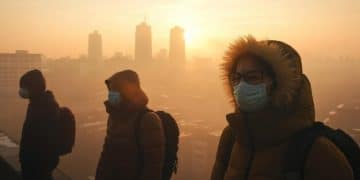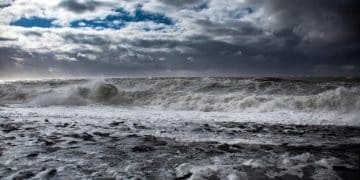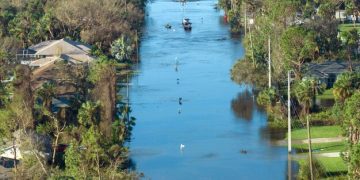Climate Change’s Impact on US Health & Respiratory Illnesses

The potential impacts of climate change on human health in the US are extensive, encompassing a surge in respiratory illnesses due to increased air pollution, longer pollen seasons, and intensified extreme weather events, alongside various other profound health consequences.
The intricate relationship between our environment and well-being has never been more apparent. As climate patterns shift, so too does the landscape of public health. Understanding what are the potential impacts of climate change on human health in the US, including respiratory illnesses, is crucial for developing effective mitigation and adaptation strategies, ensuring a healthier future for all.
Rising Temperatures and Air Quality Degradation
The escalating global temperatures, a hallmark of climate change, do not merely signify warmer days. They intricately interact with our atmospheric composition, leading to a profound degradation of air quality. This complex interplay presents a direct and measurable threat to human respiratory health across the United States.
Higher temperatures accelerate the formation of ground-level ozone, a potent air pollutant formed when nitrogen oxides and volatile organic compounds react in sunlight. Ozone, even at moderate concentrations, can irritate the airways, reduce lung function, and exacerbate pre-existing respiratory conditions like asthma and chronic obstructive pulmonary disease (COPD). The impact is particularly severe during prolonged heatwaves, which are becoming more frequent and intense due to climate change.
Ground-Level Ozone: A Respiratory Hazard
Ground-level ozone is not directly emitted but forms through chemical reactions. The warmer and sunnier conditions associated with climate change act as catalysts for these reactions, increasing ozone concentrations, especially in urban and suburban areas. This invisible pollutant can penetrate deep into the lungs, causing inflammation and damage.
- Irritation of the respiratory tract, leading to coughing, sneezing, and sore throat.
- Decreased lung function and increased susceptibility to respiratory infections.
- Exacerbation of asthma, emphysema, and bronchitis symptoms.
- Increased hospital admissions and emergency room visits for respiratory ailments.
Particulate Matter and Wildfires
Beyond ozone, climate change contributes to an increase in particulate matter (PM) pollution, particularly from wildfires. Rising temperatures and drought conditions create a more conducive environment for wildfires, which release massive amounts of fine particulate matter into the atmosphere. This PM2.5, particles smaller than 2.5 micrometers, can bypass the body’s natural defenses and lodge deep in the lungs or even enter the bloodstream.
Exposure to wildfire smoke, even for short periods, can trigger acute respiratory symptoms. For individuals with chronic respiratory conditions, prolonged exposure can lead to severe complications and even premature death. The geographical reach of wildfire smoke, carried by prevailing winds, means that communities far from the actual fire sites can also experience significant health impacts.
The combined effects of increased ground-level ozone and particulate matter from wildfires paint a grim picture for respiratory health in the US. These pollutants do not act in isolation; their synergistic effects can amplify the burden on the respiratory system, demanding robust public health interventions.

Allergen Season Extension and Intensification
Climate change is intricately altering the phenology of plants, particularly those responsible for producing aeroallergens like pollen. This shift manifests as extended and intensified allergy seasons, posing a significant challenge to individuals prone to respiratory allergies and asthma across the United States.
Warmer temperatures and increased atmospheric carbon dioxide (CO2) concentrations act as powerful stimulants for plant growth and pollen production. Plants like ragweed, a notorious allergen, thrive under elevated CO2 levels, producing more potent pollen for longer durations. This leads to a higher cumulative pollen exposure throughout the year, overwhelming the immune systems of susceptible individuals.
Longer Pollen Seasons
The frost-free season has lengthened in many parts of the US due to climate change, allowing plants to begin pollinating earlier in the spring and continue later into the fall. This extended period of pollen release means that individuals with seasonal allergies experience symptoms for a greater portion of the year, increasing their discomfort and potentially exacerbating chronic respiratory conditions.
Evidence suggests that the pollen season in some regions of the US has lengthened by several weeks over the past few decades. This trend is projected to continue, impacting millions of Americans who suffer from allergic rhinitis and asthma.
- Earlier onset of spring pollen seasons.
- Delayed end of fall pollen seasons.
- Increased cumulative exposure to allergens.
- Higher incidence and severity of allergic rhinitis symptoms.
Increased Pollen Potency
Beyond just duration, climate change also appears to be influencing the potency of pollen. Studies indicate that elevated CO2 levels can lead to ragweed producing more allergenic pollen grains. This means that even if the concentration of pollen in the air doesn’t dramatically increase in some areas, the pollen itself might trigger stronger allergic reactions due to its enhanced allergenicity.
The interplay of longer seasons and more potent pollen creates a “double whammy” for respiratory allergy sufferers. It translates to more frequent and severe asthma attacks, increased reliance on medication, and a negative impact on quality of life and productivity.
The extended and intensified allergen seasons contribute to a higher burden of respiratory morbidity, requiring enhanced public health surveillance and preparedness for managing allergic conditions in a changing climate.
Extreme Weather Events and Respiratory Health
The escalating frequency and intensity of extreme weather events, a direct consequence of climate change, pose multifaceted threats to human respiratory health in the US. These events, ranging from heatwaves to floods and severe storms, do not merely cause immediate physical harm but also trigger a cascade of environmental changes that directly impact the respiratory system.
Heatwaves, for instance, are not only dangerous due to direct heat stress but also by exacerbating air pollution. Stagnant air associated with high-pressure systems during heatwaves traps pollutants close to the ground, leading to spikes in ozone and particulate matter concentrations. This creates a respiratory hazard, particularly for vulnerable populations such as the elderly, young children, and individuals with pre-existing respiratory conditions.
Flooding and Mold Growth
Increased heavy precipitation and devastating floods, another consequence of climate change, create ideal conditions for mold growth in homes and buildings. Mold, particularly certain species like Stachybotrys chartarum (black mold), releases spores that can trigger allergic reactions, asthma attacks, and other respiratory symptoms in sensitive individuals.
After a flood event, water damage often remains for extended periods, providing a conducive environment for mold proliferation. Respiratory illnesses linked to mold exposure can range from nasal congestion and coughing to more severe conditions like hypersensitivity pneumonitis. The rebuilding and recovery efforts post-flood also expose individuals to mold, dust, and other irritants, further complicating respiratory health.
- Increased prevalence of mold-related respiratory symptoms.
- Exacerbation of asthma and other allergic respiratory diseases.
- Potential for chronic respiratory conditions due to prolonged exposure.
- Challenges in housing and indoor air quality post-disaster.
Severe Storms and Dust Exposure
Severe storms, including intense hurricanes and tornadoes, can lead to significant structural damage, releasing large amounts of dust, debris, and irritants into the air. In addition, these storms can disrupt critical infrastructure, impacting access to healthcare and emergency services for individuals experiencing respiratory distress.
The long-term effects of exposure to storm-related debris and indoor pollutants can contribute to persistent respiratory symptoms and a heightened risk of chronic lung diseases. These events underscore the need for resilient public health infrastructure and emergency response systems that can effectively address the respiratory health impacts of extreme weather.
The compounding effects of extreme weather events on air quality, mold exposure, and the general disruption of daily life amplify the burden of respiratory illnesses, requiring comprehensive public health preparedness and adaptation strategies.
Vector-Borne Diseases with Respiratory Manifestations
While typically associated with illnesses like Lyme disease or West Nile virus, climate change’s influence on vector-borne diseases is also beginning to show less direct, but significant, impacts on respiratory health. Specifically, changes in temperature, precipitation patterns, and humidity can alter the geographic range and seasonality of certain vectors, leading to the emergence or re-emergence of diseases that may involve respiratory symptoms as part of their clinical picture.
For instance, certain zoonotic diseases, which are transmitted from animals to humans, can be influenced by climate change due to altered host-vector dynamics. While not direct respiratory illnesses in the conventional sense, some of these infections can present with notable pulmonary involvement, complicating diagnosis and treatment.
Hantavirus Pulmonary Syndrome
Hantavirus Pulmonary Syndrome (HPS) is a severe, often fatal, respiratory disease caused by hantaviruses. People become infected when they inhale aerosolized virus particles from the urine, droppings, or saliva of infected rodents. Climate-induced changes, such as altered rainfall patterns leading to increased food availability, can cause rodent populations to boom, particularly deer mice in the US.
Increased rodent populations, especially in proximity to human habitation, heighten the risk of hantavirus exposure. While HPS is relatively rare, its severity and the respiratory distress it causes make it a significant concern. The initial symptoms often mimic the flu, but can quickly progress to severe breathing difficulties, fluid in the lungs, and cardiogenic shock.
The potential for climate change to influence the epidemiology of diseases like HPS underscores the broad and sometimes unexpected pathways through which environmental shifts can impact human respiratory health.

Socioeconomic Vulnerability and Health Disparities
The impacts of climate change on human health, particularly respiratory illnesses, are not uniformly distributed across the US population. Pre-existing socioeconomic inequalities significantly amplify vulnerability, leading to disproportionate burdens on marginalized communities. This stratification of risk creates profound health disparities, where those with the fewest resources often bear the brunt of climate-related health consequences.
Low-income communities and communities of color are frequently located in areas with higher baseline levels of air pollution, such as near industrial facilities or major transportation arteries. These communities may also have older housing stock that is less resilient to extreme weather events, increasing exposure to indoor allergens like mold after floods, or lacking adequate cooling systems during heatwaves, leading to worse indoor air quality.
Pre-existing Health Conditions and Access to Care
Individuals in vulnerable communities often suffer from a higher prevalence of chronic health conditions, including asthma, COPD, and cardiovascular diseases, which are exacerbated by environmental stressors associated with climate change. Compounding this, access to quality healthcare, including specialists and preventative services, may be limited due to financial barriers, lack of insurance, or geographical distance.
When climate events occur, these communities face additional challenges:
- Limited financial resources for evacuation or post-disaster recovery.
- Inadequate warning systems or communication in multiple languages.
- Disruption of essential services, including healthcare and transportation.
- Increased psychological stress which can indirectly impact physical health.
Occupational Exposure
Certain occupations also increase respiratory health risks in a changing climate. Outdoor workers, such as agricultural laborers and construction workers, face prolonged exposure to heat, air pollutants, and allergens. As temperatures rise and extreme weather events become more common, these workers are at heightened risk of heat stress, respiratory irritation, and exacerbation of existing lung conditions.
Moreover, occupational settings can expose workers to other climate-related hazards, like wildfire smoke or dust from drought-affected areas, further compounding their respiratory health risks. The interplay of socioeconomic status, geographic location, and occupational exposure creates a complex web of vulnerability that demands targeted interventions and equitable adaptation strategies.
Addressing these socioeconomic vulnerabilities is not just a matter of public health but also social justice, ensuring that climate change adaptation benefits all segments of society, particularly those most at risk.
Mental Health and Climate Anxiety
While not directly a respiratory illness, climate change’s pervasive influence on mental health, particularly through climate anxiety and eco-distress, plays an indirect but significant role in overall human health, including the perception and management of physical symptoms. The constant bombardment of news about environmental degradation, extreme weather events, and future uncertainties can lead to a range of psychological responses that can impact physical well-being.
Climate anxiety, often characterized by chronic fear of environmental doom, can trigger a physiological stress response. Prolonged stress is known to suppress the immune system, increase inflammation, and exacerbate chronic conditions. For individuals with respiratory conditions like asthma, stress and anxiety can directly trigger or worsen symptoms. This creates a vicious cycle where environmental stressors induce mental distress, which in turn adversely affects physical health.
Stress and Physiological Responses
The human body’s “fight or flight” response, when activated chronically by climate anxiety, can lead to:
- Increased heart rate and blood pressure.
- Shallow, rapid breathing (hyperventilation), which can irritate airways.
- Muscle tension, potentially affecting breathing mechanics.
- Release of stress hormones like cortisol, which can contribute to systemic inflammation and immune dysregulation.
These physiological changes, while not causing respiratory illness directly, can make individuals more susceptible to environmental triggers. For example, a person experiencing heightened anxiety might perceive air quality issues more acutely or have a lower threshold for experiencing asthma symptoms.
Impact on Health Behaviors
Chronic mental distress can also influence health-seeking behaviors. Individuals deeply affected by climate anxiety might experience apathy, despair, or difficulty engaging in preventative health measures. They may overlook early symptoms of respiratory issues or delay seeking medical attention, potentially leading to more severe conditions.
Conversely, some may become overly preoccupied with every environmental trigger, leading to an exaggerated perception of symptoms. While this doesn’t cause physical illness, it can consume mental energy and detract from daily functioning.
Recognizing and addressing the mental health impacts of climate change is therefore an integral part of a holistic approach to public health. Supporting mental well-being can build resilience, enabling individuals to better cope with the physical challenges posed by a changing climate, including those affecting respiratory health.
| Key Impact | Brief Description |
|---|---|
| 💨 Air Quality Degradation | Increased ozone and wildfire smoke exacerbate respiratory conditions. |
| 🌿 Extended Allergy Seasons | Warmer temperatures lead to longer, more potent pollen seasons. |
| 💧 Mold from Flooding | Increased heavy rainfall promotes mold growth in homes, affecting respiratory health. |
| 📉 Health Disparities | Vulnerable communities face disproportionate respiratory health burdens. |
Frequently Asked Questions
▼
Climate change intensifies asthma symptoms through various mechanisms. Increased temperatures lead to higher ground-level ozone, a lung irritant. Longer, more intense pollen seasons expose asthmatics to allergens for extended periods. Furthermore, extreme weather events like wildfires generate airborne particulate matter, and floods promote mold growth, all of which are powerful asthma triggers.
▼
Wildfires, amplified by drier and hotter conditions due to climate change, release vast quantities of fine particulate matter (PM2.5) into the atmosphere. Inhaling these microscopic particles can cause acute respiratory symptoms, inflammation, and exacerbate pre-existing conditions like asthma and COPD. Smoke can travel long distances, affecting communities far from the fire source and increasing hospital admissions for respiratory distress.
▼
Yes, certain populations are disproportionately vulnerable. Children, the elderly, individuals with pre-existing respiratory conditions, and low-income communities often face higher risks. These communities may reside in areas with poorer baseline air quality, have limited access to healthcare, or live in housing more susceptible to climate-related damages like mold intrusion after floods, compounding their respiratory health burdens.
▼
Climate change contributes to increased rainfall and flooding, creating ideal conditions for mold growth in homes and buildings. Mold spores, when inhaled, can trigger allergic reactions, asthma attacks, and other respiratory symptoms like coughing and wheezing. Prolonged exposure to mold, particularly after flood events, can lead to chronic respiratory issues and exacerbate existing lung conditions, requiring extensive remediation efforts.
▼
Individuals can take several steps to protect their respiratory health amidst climate change impacts. These include monitoring air quality alerts, staying indoors and using air purifiers during periods of high pollution or wildfire smoke, managing existing respiratory conditions with proper medication, consulting healthcare providers for allergy management, ensuring good indoor air quality at home, and advocating for climate action and public health policies.
Conclusion
The intricate web of connections between climate change and human health, particularly respiratory illnesses, is undeniable and increasingly urgent within the US. From the insidious rise in ground-level ozone and wildfire smoke to the extended grip of allergy seasons and the proliferation of mold after extreme weather, the implications for our lungs are profound. Understanding these multifaceted threats is the first critical step toward building resilience. It mandates not only robust public health infrastructure for monitoring and intervention but also a societal commitment to mitigating climate change at its source. Our collective respiratory health hinges on immediate and sustained action.





